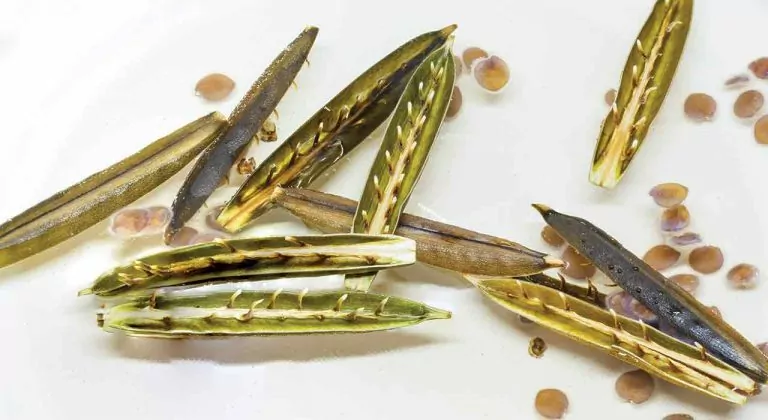Sometimes when my husband and I sit quietly in our house, maybe reading, or drinking coffee, we hear a barely audible “pop” followed by a tiny clattering sound of something hitting the floor.
Mind-blowing mechanisms
The “something” here are seeds, each about two millimeters wide, landing up to a meter away from the plant that has launched them. This happens a lot in our house because we started with two such plants about 15 or 20 years ago, and now we have many of these Euphorbia leuconeura or “Madagascar Jewels.” Their seeds often land in their own pot or in the pots of other plants where they happily germinate.
While the plant is threatened because of habitat loss in its native Madagascar, that is not so at our house! It grows well, up to six feet tall in areas that are not too bright. The angular stem looks something like a cactus, as do some other Euphorbias, and it contains a mildly toxic milky fluid which has never been a problem to us, our grandchildren or our pets as everybody “leaves” the plant alone.
The flowers of Euphorbias are all very small – the Madagascar Jewel has just tiny white flower clusters. The plant’s claim to fame, apart from its attractive and unusual appearance, is definitely its habit of explosively dispersing its seed far and wide.
Flowering plants have been designed with various interesting seed dispersal mechanisms, everything from prickly burrs that ride along on passersby, to wings or parachutes attached to seeds to enable them to ride along on wind currents. Some seeds are even dispersed from the intestines of animals that ate the fruits. However the device of explosively ejecting seeds requires some fancier engineering than many seed dispersal mechanisms.
Too fast for the naked eye to track
One plant that has recently attracted attention in this regard is Ruellia ciliatiflora or “hairy-flower wild petunia.” Ruellia is no relation of real petunias. Rather hairy-flower wild petunia is classified in the family Acanthaceae, made up of mostly tropical herbs, shrubs and vines. The flowers in this family all develop into a two-celled fruit capsule that ejects seeds more or less explosively. Ruellia (named after a 16th century French botanist Jean Ruelle) may be toxic and it may be used in some medicinal applications, but, once again, its real claim to fame is the highly explosive ejection of its seeds from the fruit capsule.
Ruellia‘s specialized seed dispersal has attracted the attention of a team of scientists with fancy high-speed cameras. Their research consisted of setting up the camera near suitable plants and filming the release of the seed. They then analyzed the recording frame by frame, and from there they calculated velocities and other details. And what interesting details they found!
The seeds of the hairy-flower wild petunia are disk-shaped, about 2.5 mm in diameter and almost 0.5 mm thick. They are ejected from the fruit capsule at speeds of 15 meters/second, or roughly 60 kilometers per hour!
They’ve even got backspin!
The plant achieves this extraordinary result by stabilizing the seeds so that they sit vertically in the air like bicycle tires. The disks spin backwards while moving forward on a rising trajectory. (It is their spinning which stabilizes their orientation.) The backspin was measured at an extraordinary 1660 cycles per second. The fact that the seeds spin backward means that drag on the surface is greatly reduced. The reduced drag means that the energy required to disperse the seeds is reduced by a factor of five. Thus the seeds are shot up to seven meters (23 feet) from the small low-lying parent plant.
These features of the hairy-flower wild petunia rightly amaze us when we consider where the energy comes from. Obviously, the energy comes from the design of the fruit capsule. It has to be so constructed that the capsule will open suddenly. This means that the connecting region between the two halves of the fruit develops a much weakened zone and a strong hinge to pull the halves apart quickly. Also the seeds have to be so shaped that they will spin and so loosely connected to their growth center in the fruit that they will be shot out spinning backward but moving forward. Any mechanical engineer will admit that the engineering of this system requires a lot of fine tuning in order to achieve these results. Such a fancy system did not just develop spontaneously (by chance) but exhibits the work of a supremely intelligent Designer.
For more on exploding seed pods, see “Imagine that” from October 2005 issue of the “Creation Science Dialogue.” This is about the dispersal of pollen grains from Bunchberry (Cornus canadensis) which has similar amazing properties – it is because of this plant that I first learned what a French implement of war, the trebuchet, was! Also, take a look at the video below.











